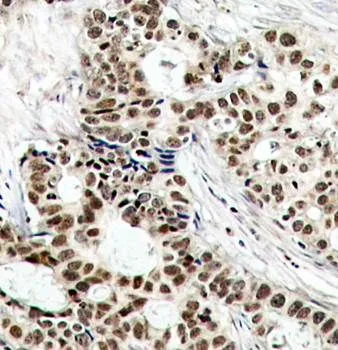BRCA1 antibody [C3], C-term
GTX100720
ApplicationsImmunoFluorescence, Western Blot, ImmunoCytoChemistry
Product group Antibodies
TargetBRCA1
Overview
- SupplierGeneTex
- Product NameBRCA1 antibody [C3], C-term
- Delivery Days Customer9
- Application Supplier NoteWB: 1:500-1:3000. ICC/IF: 1:100-1:1000. *Optimal dilutions/concentrations should be determined by the researcher.Not tested in other applications.
- ApplicationsImmunoFluorescence, Western Blot, ImmunoCytoChemistry
- CertificationResearch Use Only
- ClonalityPolyclonal
- Concentration1 mg/ml
- ConjugateUnconjugated
- Gene ID672
- Target nameBRCA1
- Target descriptionBRCA1 DNA repair associated
- Target synonymsBRCAI, BRCC1, BROVCA1, FANCS, IRIS, PNCA4, PPP1R53, PSCP, RNF53, breast cancer type 1 susceptibility protein, BRCA1/BRCA2-containing complex, subunit 1, Fanconi anemia, complementation group S, RING finger protein 53, breast and ovarian cancer susceptibility protein 1, breast cancer 1, early onset, early onset breast cancer 1, protein phosphatase 1, regulatory subunit 53
- HostRabbit
- IsotypeIgG
- Protein IDP38398
- Protein NameBreast cancer type 1 susceptibility protein
- Scientific DescriptionThis gene encodes a nuclear phosphoprotein that plays a role in maintaining genomic stability and acts as a tumor suppressor. The encoded protein combines with other tumor suppressors, DNA damage sensors, and signal transducers to form a large multi-subunit protein complex known as BASC for BRCA1-associated genome surveillance complex. This gene product associates with RNA polymerase II, and through the C-terminal domain, also interacts with histone deacetylase complex. This protein thus plays a role in transcription, DNA repair of double-stranded breaks, and recombination. Mutations in this gene are responsible for approximately 40% of inherited breast cancers and more than 80% of inherited breast and ovarian cancers. Alternative splicing plays a role in modulating the subcellular localization and physiological function of this gene. Many alternatively spliced transcript variants have been described for this gene but only some have had their full-length natures identified. [provided by RefSeq]
- Storage Instruction-20°C or -80°C,2°C to 8°C
- UNSPSC12352203

![IHC-P analysis of human ovarian carcinoma tissue using GTX17251 BRCA1 antibody [GLK-2].](https://www.genetex.com/upload/website/prouct_img/normal/GTX17251/GTX17251_20191203_IHC-P_37_w_23060620_464.webp)
![ELISA analysis of antigen using GTX60779 BRCA1 antibody [6C6D2]. Black : Control antigen 100ng Purple : Antigen 10ng Blue : Antigen 50ng Red : Antigen 100ng](https://www.genetex.com/upload/website/prouct_img/normal/GTX60779/GTX60779_20170912_ELISA_w_23061123_439.webp)
![IHC-P analysis of human breast carcinoma tissue using GTX34445 BRCA1 antibody [BRCA1/1398].](https://www.genetex.com/upload/website/prouct_img/normal/GTX34445/GTX34445_20200115_IHC-P_343_w_23060801_657.webp)


